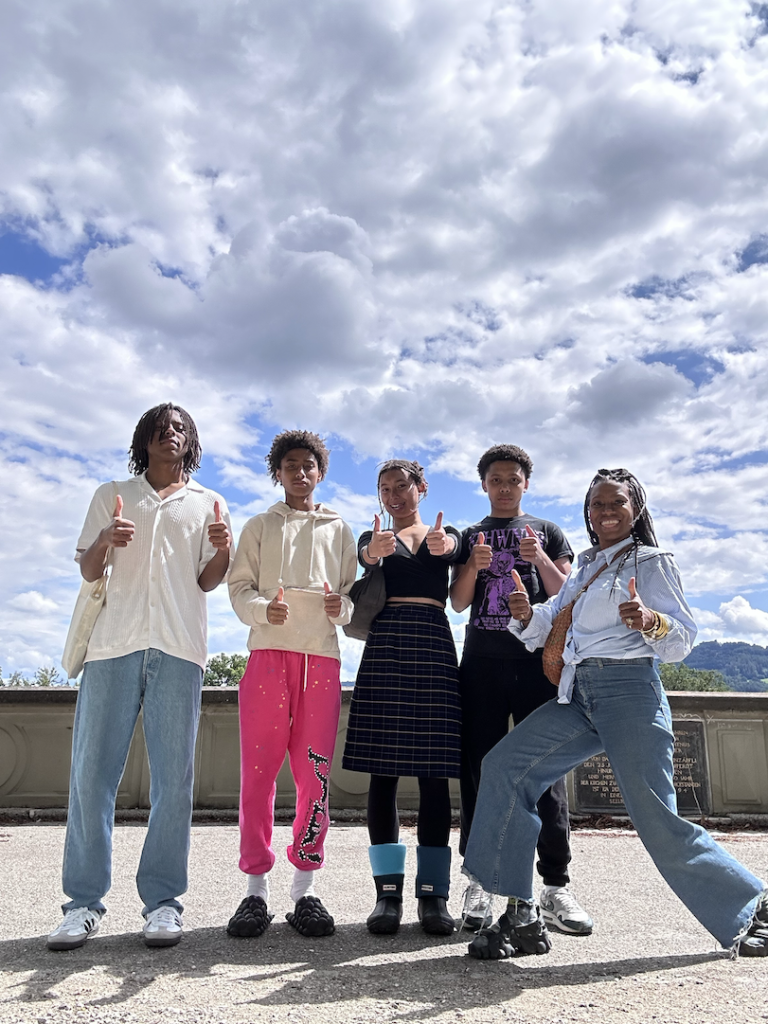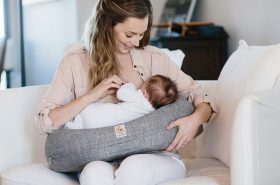
Jodie Patterson’s family story is a story of authenticity, courage, and love. At three years old, her third child told her they were a boy and from there, the trajectory of what motherhood looked like shifted. She has become a widely sought after voice in the community for LGBTQIA+ activism. She is an entrepreneur, and writer, sits on the board of several gender/family/human rights organisations, including the Human Rights Campaign, and is a public speaker addressing a wide range of audiences about identity, gender, beauty, and entrepreneurship. Jodie was also appointed by the United Nations as a Champion of Change. She lives in Brooklyn, New York, where she co-parents her five children with love, education, and family solidarity.
We got to ask Jodie a few questions about raising a trans child. Here’s what she had to say:
Your family’s story is a story of authenticity, courage, and love. How has parenting been different from what you imagined?
I used to think mothering was rooted in the soft, emotional and often invisible work like scheduling and planning for the ones we love. I saw it as mostly up-close work, with hugs, kisses and snuggly affirmations. But now I understand it differently, because so much of Mothering happens when no one is happy. It is in the tough moments, the places where we disagree, and in the rub, where the strength of Mothering can secure people – building compassion and dignity. It’s also a whole lot of mapping and strategic planning, like the way city planners design entire communities, taking into consideration how diverse people can co-exist. To me, Mothering is the building of mini cities.

I read a bit on your perspective about parenting with diversity and you shared how you noticed your friend groups all looked like you. So, you mandated that your family make new friends that year. Can you tell me what it was like for your family to search for new friends that looked and thought differently than you? Where did you even begin? And how did that go? What did you and your kids learn? As an introvert, this sounds like a BIG undertaking!
The problem stems from the narrow way in which we think about our families. When I talk about families I mean the biological, chosen, even the boardroom and office families. Family in the broadest sense, wherever people dwell together. One year, I took a look at my [Facebook] friends. Everyone in my curation looked like me – Black, cisgender, privileged, female, over 50, upper middle class, educated. Mostly moms. And at one point I thought that was a good thing because I was taught that Black women as a collective are smart, empathetic, trustworthy and supportive. But when I realised my friend group didn’t include my own son, or the millions of people who identify as transgender, I was disgusted with my narrowmindedness. I mandated that going forward, the entire family had to expand our friend group. We didn’t have to get rid of friends. But we had to make new ones – and those new friends had to be gender non-conforming, trans, or non-binary. I knew how awkward that sounded, but I also knew that if I didn’t demand it, if I wasn’t intentional, we would remain complacent in our cisgender, straight, upper middle-class bubble.
The question then became: How do we make friends who are different? I knew the community that I had neglected, so I went straight to it. One summer I made a list of all the LGBT conferences nationwide. I went to the ones I could drive, train or bus to. I sat in the back of those rooms and listened and absorbed. I felt in over my head and I didn’t speak at first. Over the course of a year – I understood more, I spoke up and I got involved. I return year after year and now I sometimes give keynotes at those conferences. I took another daring leap – I packed up the family and took us all to a trans family sleep away camp in the woods. We’ve gone back each year for a decade – having fun, building community and deepening our knowledge. I’ve applied that widening approach beyond how we socialise.
Now, even the businesses I work with, the schools I send my kids to and the organisations I stand side by side with, all have to be trans supportive, LGBTQAI friendly, feminist, and pro-Black. Non-negotiable. As a result, our friend group today is way more diverse than before in so many ways: gender, race, age, body size, socioeconomics, regionality. My children understand and experience “DEI” in real-life. For us it’s not simply a tagline.
When your third child was 3, he told you he was a boy. What was your response to this? Is it something you expected? Can you tell us about learning your child is transgender and how it shifted your parenting and perspective on the world?
10 years ago, the world was much more ignorant of gender diversity than it is now. Laverne Cox wasn’t on Orange is the New Black, the hit T.V. show. Pose hadn’t yet debuted and Catlin Jenner’s prophetic words were not broadcasted on national television, “My brain is female”. All I knew was that my child was rebellious, temperamental and extremely strong-willed. I saw them refusing to get dressed, to brush their hair, and to play nicely with friends. I also witnessed their crippling anxiety in the form of recurring nightmares – “Mama the monster is coming to get me.” Eventually, when they opened up, what they said shocked me; “Mama, I love you but don’t want to be you. I want to be Papa.” I thought to myself, “She’s going to be tough, maybe a lawyer, or a feminist.” (As good as my intentions were, I was missing the point entirely.) I thought that I was witnessing a girl who was frustrated by the differences in how we treat boys vs girls. And so, I responded in solidarity, “If your insides feel strong like a boy, then go ahead and act like a boy.” My child quickly corrected me, “No mama, I don’t feel like a boy. I am a boy.” At the time, I didn’t know what transgender meant. So, I prodded and asked questions, read a lot and observed him. And over time I understood the science and biological fact of gender diversity. Some people are naturally cisgender, like myself, some are naturally transgender like my son, and others are gender queer. In fact, there are infinite gender identities. But more importantly I learned to relax and simply honour my son’s sense of self.
From that point on I realised that everyone’s gender identity is unique and very personal. It is how we see ourselves in the world, not necessarily how others see us. For my son, his masculinity is a very permanent state of being, not a fluctuating emotion or phase. As the years progressed, and as obstacles presented themselves, he remained persistent and consistent with his identity. I simply wasn’t interested in poking holes in his truth. When we’re responsible for leading a diverse team, it’s important to build people up, and support their authenticity. Leaders, aka mothers, shouldn’t centre gender norms, or cisgender culture, or straight culture (where boys do this and girls do that). A better way of leading, I found, is to encourage our people to experience all of life. Now I say to my children: Where you go, I will follow. Who you are, I will support. What you know I will learn.
In what ways have you needed to advocate for your trans child? What about his siblings?

I advocate for his safety, education, dignity so that he has access to a full life. There is so much misinformation around gender identity and the people making laws and decisions about trans lives and trans bodies often don’t even know trans people. Many of us confuse gender identity with biological sex, sexuality. So as a mom raising a trans person who is also Black, I’ve gotten very comfortable pre-emptively walking into rooms before my children do, to make sure they are safe. Camps, schools, doctor’s offices, sports teams, friends’ homes – wherever my children want to be – I enter first and speak freely about who we are and what we stand for. If I sense awkward or uncomfortable pushback, I’m prepared to leave immediately – because sometimes physical and mental safety is the only thing on my mind.
At other times, I’m prepared to hold our ground and fight for our rights. I’m often with politicians, policy makers, corporate leaders, educators and influencers pushing for more understanding and a shift in our laws. There is not a space in this world that is not entangled with bias. Even in the most loving spaces, we still hold racism, sexism, and transphobia. Just as I, years ago, didn’t fully see or understand my child, we all have blind spots. Most of the work I do now is with educators, health care providers, corporate leaders and parents – people who are responsible for diverse communities. I help us understand how to best lead with awareness, empathy, and an egalitarian strategy.
What are some ways you’ve seen support, rights, and advocacy improve for queer kids over the years?
I work directly with our nation’s largest LGBTQAI organisation – The Human Rights Campaign. I was the first Black person appointed as Chair of the national board of directors. From that specific vantage point, I’ve witnessed tremendous success in fighting unjust bills that target trans people. We have a 90% track record with shooting down harmful legislation. So even though these bills are coming at us faster and are more diabolical than ever before, we’ve been able to shut them down. Trans visibility is in books, television shows and on social media – and not just with celebrities but also with real people like my family, who’s story has become globally recognised. I think visibility and proximity are key components to acceptance, love and peace. The closer our lives are intertwined, the less scary our differences become.
But it’s also important to note that visibility can also bring vulnerability – we’ve seen more hate crimes year after year. It’s important to hold our politicians, corporate and community leaders, and ourselves accountable to maintaining safe spaces. On a micro level, I’ve seen good change – schools are shifting to make classrooms and common spaces gender neutral, books are being published that tell triumphant stories of trans lives, and more and more families are acknowledging and supporting their trans loved ones. 1 out of 5 Gen Z identify as LGBT, 20 million adult Americans identify at LGBT*, we are one of the fastest growing constituencies. This new reality can bring forth a much-needed shift in our hearts and minds as well as in our laws and societal norms.
In what ways do we still have improvements to make?
50% of all trans teens attempt suicide simply because of the isolation and rejection they experience from the cis community**. Hundreds of trans people are murdered each year, by cisgender people, just for being trans. 27% of trans people have their gender affirming care denied by insurance at least once. I want us to become a country that isn’t provoked into violence because of our differences. I want our trans children to grow up to be trans adults. I want my son and the millions of trans identified people to have easy, dignified and affordable access to health care. When I realised I can receive estrogen as a cis woman going through menopause, faster than a trans woman can, I realized the hypocrisy. I want an end to life-threatening hypocrisy.
If you could say anything to a parent that has a child who just shared their transgender identity, what would you say?
First and most important I’d say, as strange and unbelievable as this may seem, please know that your child is natural and normal. This is not a new phenomenon or a trend, trans people have existed in all parts of the world from the beginning of time with a rich global history. A simple statement of love is the best place to start. “I love you and thank you for letting me understand you in this way. Please tell me more.” Next, go behind the scenes and read / watch / listen as much as you can on the subject. Do the hard work without telling your child how hard it is. Trans 101 by Nick Teich is a great first book. The Bold World, a book I wrote, was called “marvellous” by Alice Walker and it shows how we can shift for the ones we love. Cosmopolitan Magazine filmed a mini documentary on my family entitled, “Mama I’m Not A Girl”. It’s used in New York as diversity training for all employees. There are dozens of podcasts on the topic. Hearing the experts talk about themselves is really helpful. And when we’re alone, practice in front of a mirror, using their preferred pronouns, until your mouth catches up with your heart. Take a Malcolm Gladwell approach to educating yourself – 10,000 hours and you can become an expert!
What insights would you share with families who don’t have queer kids? Is there anything you’d like these families to understand or learn or consider?
Someone once said to me: If you don’t have a trans kid you’re never going to read books about trans people let alone try to understand them.” That simply doesn’t hold up. At this point everyone knows someone who is transgender – a friend, student, co-worker, neighbour, loved one. Get to know them. It’s our duty […] to learn about each other. Gender is confusing and we may never fully understand it, but hey, I don’t fully understand how cell phones actually work and I still use and respect my smart phone with full confidence. One of my favourite music groups, The Roots, put it so poignantly: “Everything’s changing around me. And I want to change too. It’s one thing I know, it ain’t cool to be no fool.” What I say is: if we stay in the dark about ourselves and the people around us, we become part of the problem. 10,000 hours is a lot to ask of everyone who isn’t a parent, but honestly it takes a lot less time to become compassionate and aware. How our children see and experience the world is important. Change is happening, whether we like it or not. And it’s smarter, to be informed. Let’s be smarter.
Are there any resources you’d share for families with queer kids?
- The Human Rights Campaign / Parents for Transgender Equality
- Ackerman Institute for Families / Gender and Family Project
- Callen Lorde Health Care Center
- Informed Consent Hormone Therapy Map
- Gender Spectrum
- Trans 101 by Nick Teich
- The Bold World & Born Ready both by Jodie Patterson
- Prideportraits.org
You wrote a book titled “The Bold World, A Memoir of Family and Transformation”. What does a Bold World look like to you?
What I wholeheartedly want, for myself and for everyone, is to stretch out and touch as much of life as possible. A bold world means freedom for all to experience and explore all aspects of life, even the things we’re told aren’t meant for us. Being bold is thinking, acting, and doing more than your gender, age, race, and position in life. When I think of the dominant feeling I want all of us to have, it’s freedom.
UK resources:
In the UK check out this incredible list of resources supporting transgender children and adults from the Terence Higgins Trust: tht.org.uk
*(around 1.5 million people over 16 in the UK. Source: 2021 census
**In the UK 92% of trans young people have thought about taking their own life, 84% of trans young people have self-harmed and 45% of trans young people have tried to take their own life. Source: Stonewall’s School Report 2017



